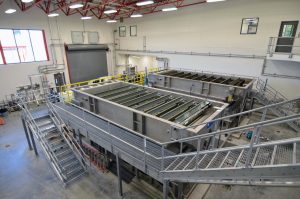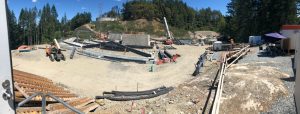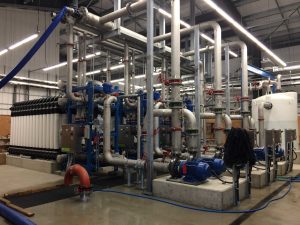What’s New in Ladysmith
Jenni Green, P.Eng
Special thanks to Chief Operator Mike Brown from the Town of Ladysmith
The Town of Ladysmith has been busy over the last five years. New Water and Wastewater Treatment Facilities have both come online since 2016 with the new Water Treatment Facility having been commissioned this past July.
Wastewater
 Figure 1 – Aerial view of the new WWTP
Figure 1 – Aerial view of the new WWTP
Ladysmith’s original wastewater treatment plant was built in 1960 and consisted of a “Spirogestor” (essentially a clarifier) and chlorine contact tank. Due to population growth in Ladysmith, as well as increasingly stringent regulation of the receiving waters, Ladysmith completed a Liquid Waste Management Plan (LWMP) which led to the plant going through a three-stage upgrade. The MWLP can be found here:
https://www.ladysmith.ca/discover-ladysmith/community-plans/liquid-waste-management-plan
Ladysmith’s WWTP discharges directly into an active shell fishery and therefore is regulated by a Conditional Management Plan (CMP) in addition to MOE permit requirements. This CMP sets out effluent requirements in conjunction with CFIA, DFO, ECCC, and MOE, and a structure to close and open the fishery in the event of plant bypasses or failures.
In 2016 the secondary treatment portion of the WWTP went online, completing the three-stage upgrade. This increased Ladysmith’s ability to treat wastewater drastically. The effluent design specs for the new facility are:
- 25 mg/l BOD (biochemical oxygen demand)
- 15mg/l TSS (total suspended solids)
- increase of capacity to 14400 m³/day
Prior to secondary treatment the Ladysmith WWTP could not maintain its existing MOE permit of 130 mg/l BOD and 130 mg/l TSS, and frequently bypassed treatment due to rain events. Since 2018 the plant has exceeded the design specs for effluent quality, with both TSS and BOD averaging less than 15mg/l.
The facility now consists of:
Primary treatment:
- Auger screens
- Grit vortex and washer
- Salsnes filters (500 micron)
Secondary Treatment:
- MBBR (moving bed biofilm reactor)
- DAF (dissolved air flotation)
Disinfection:
- Sodium hypochlorite injected at chlorine contact tank
- Calcium thiosulfate injected after contact tank
Sludge Handling:
- Sludge is stored in two separate holding tanks, one for primary and one for secondary
- The two sludges are mixed prior to dewatering via centrifuge
- Dewatered sludge is then taken to our compost facility
The fundamental difference as the new wastewater facility is the design of the moving bed biofilm reactor (MBBR) and dissolved air flotation (DAF) systems. With MBBR technology microorganisms grow on media, creating zones of higher dissolved oxygen (DO) near the outside and lower in the center. This helps with growing a diverse population of microorganisms. When growth exceeds the surface area of the media, the floc is simply sloughed off where it is picked up by the DAF. This design eliminates the constant need to adjust return activated sludge (RAS) and waste activated sludge (WAS) rates, and to test mixed liquor suspended solids (MLSS) as would be necessary in a more conventional activated sludge plant. The other benefit to the MBBR is its resilience to changing influent BOD loading. Ladysmith has a considerable amount of inflow and infiltration (I&I) and can see surges that exceed five times the dry weather flow during heavy rain events. To date, the MBBR has been able to maintain treatment after these events of cold, low BOD influent flows, without the need for a significant period of regrowth or seeding.
The Town is also in the midst of completing a UV pilot project at the WWTP. This was recommended at part of the LWMP and fueled by a need to eliminate or reduce the amount of Norovirus in the effluent that can infect shellfish in the receiving waters. If successful, UV will replace the current chlorination/de-chlorination disinfection system. The town worked with our WSP consulting engineers, and Tim Green from Vancouver Island University (VIU) on the pilot. Because Norovirus can’t be tested for directly, samples must be tested for indicators called Male Specific Coliphage (MSC). VIU was able to work with the Town to complete this testing, as no lab in BC tests for this parameter. Samples were taken by Operators and stored in a portable freezer at -80°C, then sent to VIU for lab testing.
Challenges
The biggest challenge Operators running the new system have faces is maintaining the Salsnes filters. While they do an excellent job in TSS reduction and have a very small footprint, they require a great deal of maintenance. Moving sludge from the filters to the holding tank can be troublesome. Screw pumps pump the sludge (3-4% solids) through 4” stainless piping from the Salsnes building underground to the sludge holding tanks. High amounts of grease in the sludge combined with colder weather cause frequent backups, and constant maintenance using high pressure heated water is needed.
The facility and its design engineers, WSP received a Canadian Consulting Engineering Award for Excellence in 2018.
 Figure 2 – Inside the new WWTP
Figure 2 – Inside the new WWTP
Water
The Town of Ladysmith was required to upgrade its water treatment facility to meet the filtration standards of the BC Surface Water Treatment Objectives. After two years of construction, The Arbutus Water Treatment Plant was commissioned in July of 2020.
 Figure 3 – New Arbutus Water Treatment Facility under construction
Figure 3 – New Arbutus Water Treatment Facility under construction
Source water flows to the plant from two water sources, Holland Lake and Stocking Lake. Upon entering the plant, water is fed through course (5mm) and fine (500 micron) screens with automatic backwash function, then through a flow control valve. After this, soda ash and poly-aluminum chloride are injected, and water then flow enters the rapid mixing chamber. After rapid mixing, flow is branched into two trains, each consisting of slow mixing flocculation chambers, then Dissolved Air Flotation (DAF) tanks. The chemically assisted DAF process is purposed to remove dissolved organics, that when reacting with chlorine disinfection, create Trihalomethanes (THMs) and Haloacedic Acids (HAAs). Waste from the DAF flows into two residual tanks that buffer effluent flow into the wastewater collection system, and ultimately to the wastewater treatment plant.
After DAF treatment, flow passes over a weir and into the buffer tank. From here it is pumped through the membranes. The membranes are GE/Suez ZeeWeed 1500 series and provide ultrafiltration with a 0.02 micron pose size. They are staged in three trains, with one train running at during winter flows and two trains running during summer flows. Membrane permeate is disinfected using chlorine gas and then pumped into a 5700 m³ reservoir. The chlorine gas system was in place prior to construction and is scheduled to be replaced with a sodium hypochlorite system in March of 2021.
 Figure 4 – Membranes being installed at the new facility
Figure 4 – Membranes being installed at the new facility
Water treatment objectives achieved by the new facility are as follows:
- Turbidity < 0.1 NTU in 99% of the measurements taken, and < 0.3 NTU at all times.
- Minimum 4-log removal or inactivation of viruses.
- Minimum 3-log removal or inactivation of Cryptosporidium parvum and Giardia lamblia.
- Removal of true colour to below the aesthetic objective of < 15 TCU.
- Reduction of DBPs to less than the GCDWQ operational objectives.
- Limit the increase in total aluminum concentrations due to treatment to < 0.100 mg/L from incoming raw water concentrations.
- Maintain a minimum 0.2 mg/L free chlorine residual throughout the distribution system.
Currently the treatment facility can supply the projected 10-year design demand of 132 L/s (125 L/s net after losses due to membrane cleaning and backwashing), and has been designed to accommodate expansion to meet the 20-year design demand 164 L/s (156 L/s net)
Challenges
The process from design to construction was met with major delays throughout. COVID-19 only amplified this when it hit in March of 2020. The unprecedented new reality coupled with ever increasing tension between the Town and the prime contractor, made for a very interesting commissioning period. Hard work by all involved prevailed and the Town has been producing excellent water quality from day one. The biggest challenge to date from an operations perspective has been keeping the pH in the treated water at a level that doesn’t impact the distribution system. With soda ash injection prior to the DAF, dosing must be in a range that accommodates healthy floc formation in conjunction with poly aluminum chloride (PACl) addition. Therefore, the raw water oH adjustment from soda ash injection is really only intended to increase alkalinity and buffer PACl addition. A new soda ash injection point was added on the membrane permeate line and Operators now able to have full control of treated water pH. The operations team is in the process of adjusting pH to 7.2, from 6.5 range, in hopes of mitigating the myriad of water service leaks that have occurred in the distribution system since completion of the new plant.
The Suez membrane system’s performance has been near flawless. Combined with the Insight online monitoring program, Operators are able to track membrane performance with ease.
